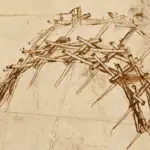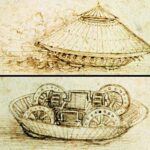Who Invented The Canal Lock?
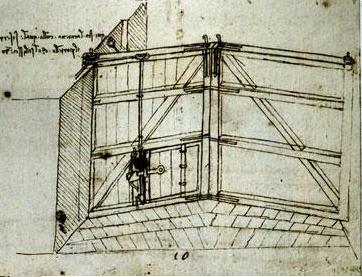
Leonardo da Vinci Canal Lock
Leonardo da Vinci’s canal lock innovation was a pivotal moment in engineering. This is the solution if you’ve ever wondered how ships travel smoothly across different water levels without a hitch.
Leonardo da Vinci revolutionized water navigation with his design of the miter gate.
By manipulating water levels, his canal lock allowed boats to move seamlessly through waterways of varying heights.
His ingenuity is still reflected in modern structures like the locks of the Panama and Suez Canals.
Many regard Leonardo’s design as an engineering marvel. His unique approach improved water navigation and set a foundation for future innovations in civil engineering.
Modern canal locks continue to benefit from his innovative thinking, proving the timelessness of his work.
When you think of Leonardo da Vinci, your mind likely wanders to his remarkable contributions to the art world, including masterpieces like The Last Supper and the Mona Lisa.
But what if we told you that da Vinci’s genius extended beyond his paintbrush, significantly shaping a critical piece of our modern navigation system: the Canal Lock?
In this article, we explore the unique mechanisms that make our waterways navigable and the profound influence of Leonardo da Vinci’s designs on their development.
Leonardo da Vinci’s Contributions to Engineering
Leonardo da Vinci played a crucial role in engineering during the Renaissance. His work on hydraulic systems, particularly his design of canal locks, showcased his innovative thinking and technical expertise.
The Renaissance Context
During the Renaissance, a period known for cultural awakening, Leonardo da Vinci emerged as a key figure in engineering. He was a polymath who excelled in art and scientific exploration.
His work went beyond traditional boundaries, combining his knowledge of anatomy, physics, and mechanics.
Leonardo’s innovations in engineering are often overlooked compared to his art. One of his significant contributions was the development of the miter lock design.
This invention allowed for better water level management, assisting boats moving through waterways with varying heights.
Advancements in Hydraulic Engineering
Leonardo made pioneering advancements in hydraulic engineering. His designs of canal locks were particularly noteworthy.
He innovated mechanisms that improved the efficiency and safety of water transport systems.
The Da Vinci canal lock system revolutionized waterway navigation. These locks had specific dimensions crafted to manage water flow and vessel movement.
By understanding the principles of water dynamics, Leonardo provided practical solutions that still influence modern engineering.
His work on the canals of Milan involved intricate designs that aided irrigation and flood control.
This blend of art and engineering demonstrated his ability to foresee and solve real-world problems through innovation. His contributions laid foundational principles that drive engineering today.
The Canal Lock System
Leonardo da Vinci played a crucial role in advancing canal lock technology. This system consisted of several innovations that improved transportation and commerce, allowing boats to navigate varying water levels quickly.
Early Canal Lock Designs
Early canal locks emerged in the 14th century, primarily in regions like Holland. These initial designs featured guillotine locks with gates at both ends.
These locks functioned by raising and lowering their gates vertically. Guillotine locks laid the groundwork for more advanced mechanisms.
These early locks enabled boats to move through canals of different heights by controlling water levels. Their designs were fundamental but pivotal in shaping future innovations, including Leonardo’s contributions.
Da Vinci’s Innovations
Leonardo da Vinci introduced a double miter lock in the 15th century. This design used water pressure to keep the gates tightly shut and is recognized for its efficiency.
This innovation significantly reduced the effort needed to operate the locks.
His approach replaced the cumbersome older portcullis-style gates. By simplifying the mechanism, canal navigation became more practical.
His contributions are a key part of canal engineering history.
Impact on Transportation and Commerce
The innovations introduced by Leonardo da Vinci profoundly impacted transportation and commerce. Da Vinci’s canal lock simplified the movement of goods and people, boosting trade between distant regions.
This transformation allowed more efficient travel and contributed significantly to economic growth in Europe.
The ability to transport larger volumes of goods through canals also enhanced trade routes, making logistics more reliable and efficient. Da Vinci’s advancements laid the groundwork for future developments in waterway engineering.
Architectural and Artistic Aspects
Leonardo da Vinci’s canal lock is a marvel of both engineering and art. He created a harmonious balance of efficient and visually engaging architecture by integrating form with function.
Integration with Surrounding Environment
Da Vinci’s canal lock design emphasized harmony with the environment. He placed significant importance on aligning the lock with the natural landscape and existing infrastructure.
It required careful planning to ensure it fit naturally into its surroundings without disrupting existing waterways.
The Leonardo da Vinci canal lock demonstrates this through smooth transitions and materials that blend with the natural surroundings.
This design approach preserved the environment and enhanced the area’s aesthetic value, showcasing Leonardo’s holistic view of engineering and nature.
Aesthetic Considerations in Functionality
Functionality and beauty coexisted gracefully in Leonardo’s designs. The canal lock’s dimensions and structure were not merely about practicality but also about creating something visually pleasing.
Da Vinci incorporated elegant lines and symmetrical shapes, making the mechanisms functional and beautiful.
In his miter lock design, the gates’ curvature and proportions added an artistic touch, showing his dedication to aesthetics even in mechanical designs.
The miter lock, used in the Panama and Suez canals, still retains this blend of practicality and beauty, underscoring the timelessness of Leonardo’s creations.
Decoding the Mechanics of Canal Locks
Before we delve into Leonardo’s impact, it’s crucial to grasp the mechanics of the canal lock. But what exactly are canal locks, and how do they work?
Canal Lock Operation System
Put canal locks are water-filled chambers that serve as elevators for boats. They allow vessels to traverse changes in water levels in our rivers and canals. The process may sound complicated, but it follows a basic yet ingenious step-by-step principle:
- A boat enters the lock, which is filled to match the waterway level from which the ship is coming.
- The gates close behind the boat, sealing it within the chamber.
- If the boat goes upstream, water is let into the chamber through valves, which raise it. If it goes downstream, water is released from the chamber, lowering it.
- Once the water level in the lock matches the level of the waterway the boat is moving to, the gates at the other end of the lock open, and the ship continues its journey.
The Birth of Canal Locks
The Maiden Lock and Its Conception
The first lock dates back to the 3rd century BC in Ancient Greece, at Palaipaphos (modern Kouklia). It was a simple yet effective design, using a single gate and a sluice system.
Who invented the canal lock? When was the canal lock invented?
- In 983 AD in China, an engineer named Chiao Wei-Yo introduced a novel idea.
- His concept involved positioning two barriers a short distance apart.
- This arrangement created a calm water pound or basin between the two barriers.
- The water in this pound could be filled or emptied at will, offering complete control over its level.
- Despite the water’s one-way flow, his design allowed boats to travel downstream and upstream.
Leonardo da Vinci’s Revolutionary Canal Lock Design
Leonardo da Vinci, the renowned polymath, was an artist and an innovative inventor. One area where his inventive genius shone was in the design and development of canal locks.
Distinguishing Leonardo’s Canal Lock from Predecessors
Da Vinci’s canal lock design was distinctly different from those that came before. It showcased his unique ability to analyze problems and develop more efficient solutions.
His canal lock was a “miter lock,” named for its two gates that met at an angle, like a miter joint in carpentry. This design was a departure from the standard straight-gated locks of his time.
The miter lock canal design allowed for a stronger seal as the water pressure forced the gates together, marking a significant step forward in the efficiency and reliability of canal locks.
Application of da Vinci’s Canals
Several famous canals, such as the Martesana Canal in Italy, utilized his canal lock designs. This canal, among others, shows Leonardo’s engineering prowess and the practical application of his miter lock design.
His influence extended far beyond Italy, eventually becoming a standard in canal engineering worldwide. The adoption of his design marked a turning point in the development of effective water navigation systems.
The World’s Most Renowned and Colossal Canal Locks
Berendrecht Lock
One of the most recognized canal locks worldwide is the Berendrecht Lock. This lock is famous for its location in Antwerp, Belgium, a city known for its rich history, spectacular architecture, and innovative design.
The Berendrecht Lock was designed to accommodate the largest seagoing vessels, making it the epitome of incredible engineering. Its advanced lock technology makes it a marvel of modern engineering and a significant achievement in water navigation.
Location of the World’s Largest Canal Lock
The Three Gorges Dam Ship Lift lock in China represents a marvel of engineering ingenuity. Its vertical design allows ships to ascend and descend an impressive 113 meters in the Yangtze River.
Unlike traditional locks, it uses a ‘ship elevator’ approach to move vessels vertically in a contained water body. This method significantly reduces the time it takes for a ship to traverse the height difference.
This colossal lock and its innovative design have made the Three Gorges Dam an essential part of global shipping routes. It is a fitting symbol of China’s significant contributions to modern canal engineering.
Profound Influence of Canal Locks on River Navigation and Trade
Role of Locks in River and Canal Systems
Canal locks are integral to our waterways, yet their importance often goes unappreciated. These innovative contrivances enable ships to traverse the varying elevations along rivers and canals smoothly. Acting as water elevators, they lift and lower vessels by manipulating water levels within enclosed chambers.
Advantages Canal Locks Offer to Navigation and Commerce
Besides aiding in navigation, canal locks have significantly bolstered trade and commerce. Here’s how:
- Streamlined Shipping: Canal locks make the movement of goods faster and more efficient. Allowing ships to bypass complicated and lengthy routes around geographical obstacles enables a swift and direct path between commercial hotspots.
- Cost Efficiency: Canal locks facilitate direct routes, helping reduce fuel consumption and overall shipping costs, which can ultimately lower consumer prices.
- Global Connectivity: Canal locks have transformed isolated regions into bustling commercial hubs, fostering economic growth and international connectivity.
Da Vinci’s Impact on Today’s Miter Locks
Da Vinci’s innovative design laid the groundwork for the modern miter locks we see today. He was the first to introduce the miter gate – a pair of gates meeting at an angle, mirroring a ‘V’ shape close to the water pressure. This design required less force to operate and utilized the water pressure to ensure a tighter seal, a principle that still holds today.
Miter Locks in Today’s Canal Infrastructure
Today, the design of miter locks owes a significant debt to da Vinci’s early work. His invention revolutionized how we manage water transport and navigate through waterways with differing levels. Modern-day miter locks, albeit more complex and mechanized, essentially adhere to the same principle established by da Vinci centuries ago.
Da Vinci’s Influence on the Panama Canal
The Panama Canal, one of the most critical shipping routes in the world, illustrates the influence of da Vinci’s work. This vital waterway, connecting the Atlantic and Pacific Oceans, relies heavily on a locks system.
They are the backbone of the canal’s functionality, enabling it to handle massive vessels carrying enormous cargo. Without da Vinci’s pioneering work in lock design, a marvel like the Panama Canal may not have been possible.
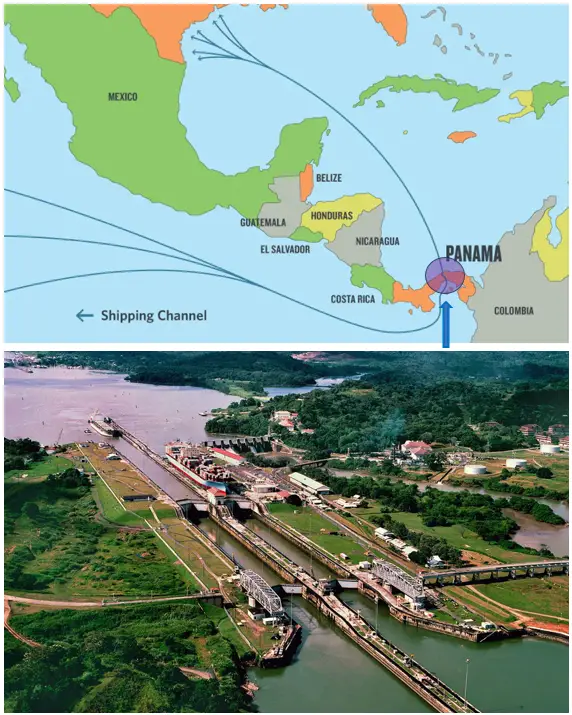
Panama Canal (blue circle location followed by the blue arrow), Panama
Leonardo da Vinci’s influence is a testament to the timeless nature of true innovation. Even centuries after his passing, his ingenious engineering drives our world forward.
Final Thoughts
Da Vinci’s unique miter lock design revolutionized the manipulation of water levels, providing a more secure and efficient way to move vessels through waterways of varying heights.
This pioneering design has been incorporated into countless canal systems worldwide, a testament to da Vinci’s enduring influence.
From enabling more efficient water transportation and facilitating global trade to influencing modern engineering marvels like the Panama Canal and canal locks, Leonardo da Vinci’s contribution to their evolution remains as relevant as ever.
As we sail into the future, the impact of canal locks on our society will continue to resonate, echoing the brilliance of innovators like Leonardo da Vinci.
The canal lock is just one more example of how revolutionary Leonardo was. It is also another example of an invention of his that has survived the test of time long after its inventor, almost making the man himself immortal.
Frequently Asked Questions
Leonardo da Vinci’s work on canal locks showcases his contribution to engineering innovations that have shaped modern waterways. His designs and ideas continue to influence the development of canal systems around the world.
Did Leonardo da Vinci invent the canal lock?
Leonardo da Vinci played a significant role in designing canal locks, particularly with his innovative miter lock concept.
Though he did not invent the canal lock, his designs revolutionized waterway navigation by providing efficient ways to manage water levels.
His work ensured safer and more effective transport through canals of varying heights.
Who designed the first canal lock?
The first canal lock design is often attributed to Chinese engineers from the 10th century.
Leonardo da Vinci is credited with significant advancements in canal lock technology during the Renaissance. His contributions focused on improving the efficiency and security of these structures.
Who designed the lock system for the Panama Canal?
The lock system of the Panama Canal was conceived by various engineers, with Edward Schildhauer and Henry Goldmark playing key roles in its creation.
In the early 20th century, their work focused on creating massive locks capable of handling large vessels. This system remains a pivotal engineering accomplishment.
Who invented the miter lock?
Leonardo da Vinci is credited with inventing the miter lock, which allowed for better control over water levels within the lock chamber.
His design introduced angled gates that closed securely against each other, preventing water loss. This concept is still used in modern lock designs around the world.
Who invented the canal lock in China?
Canal locks in China date back to ancient times, with Chhiao Wei-Yo being an early engineer responsible for significant developments around the 10th century.
His innovations helped in managing water levels for navigation on Chinese waterways. These early inventions laid the groundwork for later lock designs.
What are Leonardo da Vinci’s main inventions?
Leonardo da Vinci’s primary inventions include designs for flying machines, an armored vehicle, a revolving bridge, and various hydraulic devices.
His work on canal locks was pivotal in civil engineering. His incredible sketches and concepts continue to inspire engineers and inventors worldwide.
Did Leonardo da Vinci invent the revolving bridge?
Leonardo da Vinci did invent a revolving bridge, which was intended for quick assembly and transportation.
Designed for military use, it could be wheeled to a site and unfolded across a gap or river. This invention highlights his ingenuity in creating practical solutions for complex problems.
What is the purpose of a lock in a canal?
A lock in a canal aims to raise and lower boats between stretches of water of different levels. This is crucial for navigating areas where water levels change due to terrain or tides.
Locks help ships move smoothly and safely along a canal without interruption.
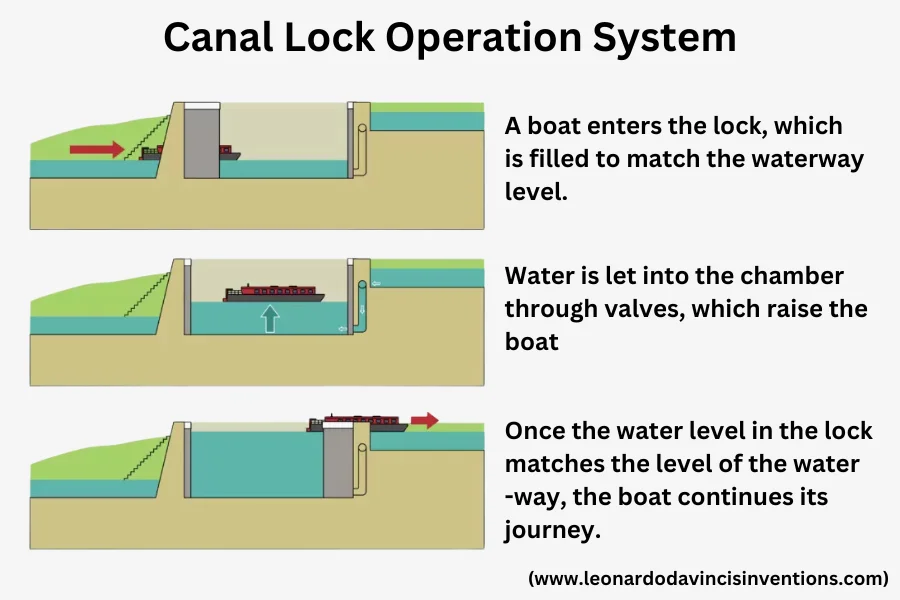
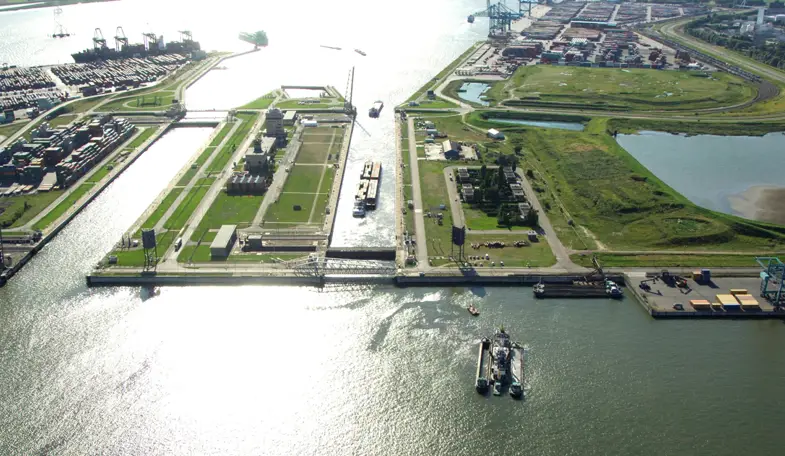
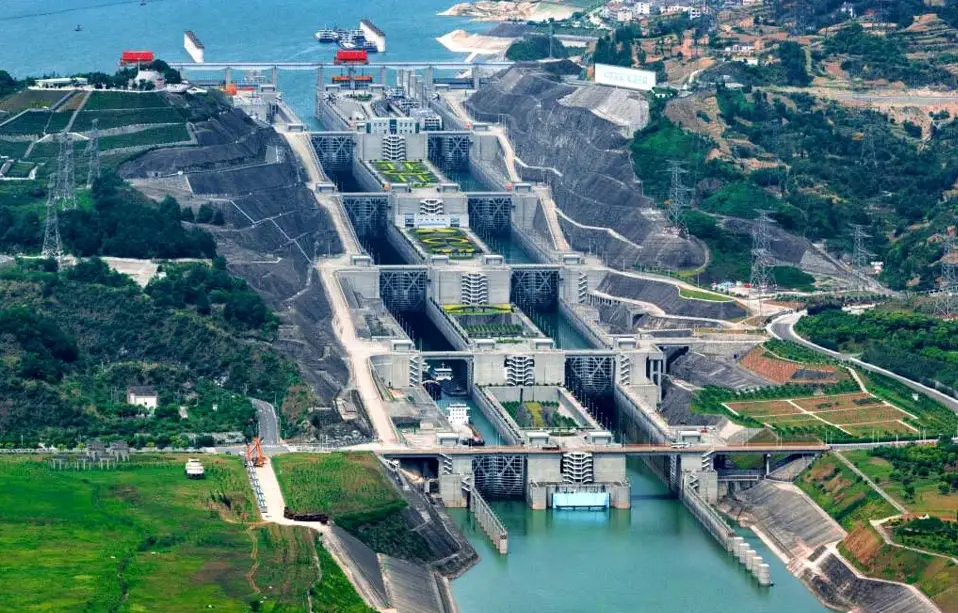

 I’m Leonardo Bianchi, the mind behind Leonardo da Vinci's Inventions. Thanks for visiting.
I’m Leonardo Bianchi, the mind behind Leonardo da Vinci's Inventions. Thanks for visiting. 